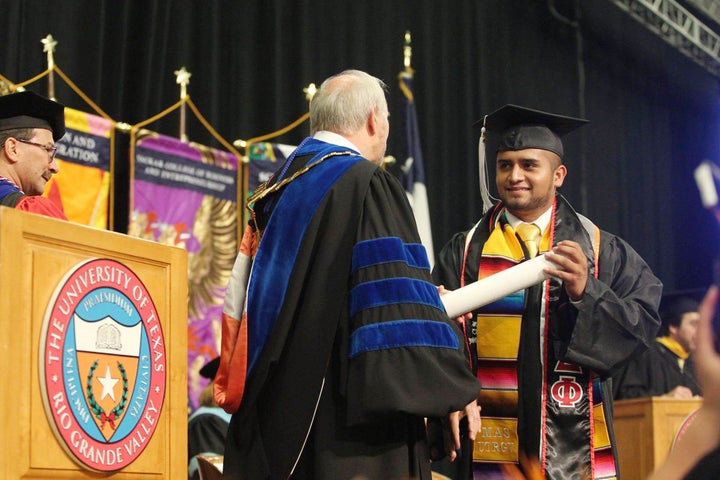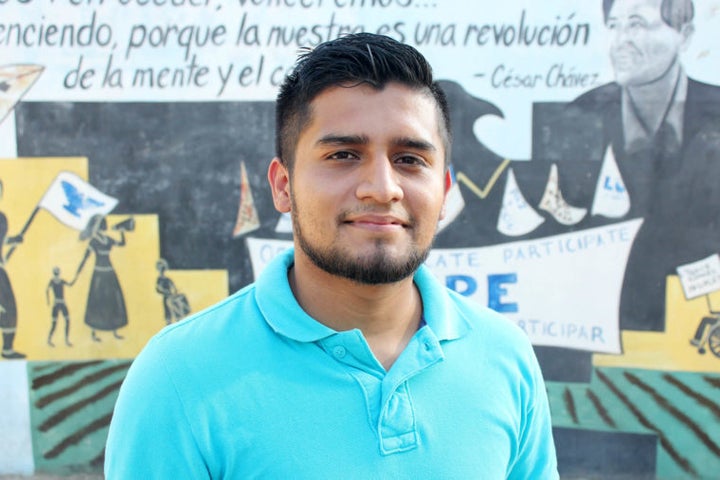
Abraham Diaz receives his diploma from the University of Texas Rio Grand Valley in May 2017.
By Tim Marema and Bryce Oates
To Abraham Diaz, the uncertainty of his immigration status in 2017 feels a lot like it did in 2012, when he felt hopeless about advancing his education and making a better life in the United States.
But there’s one big difference.
Diaz now knows what it feels like to live in the United States without fear of deportation or second-class status. For the past five years, Diaz has lived “out of the shadows” via the Deferred Action on Childhood Arrivals executive order of 2012.
“The difference is that now I’ve already felt what contributing to America feels like,” said Diaz, aged 24, who came to the U.S. from Mexico with his family when he was 8 years old. “I know how it is different to be part of America and to contribute to it in so many ways. I’m not ready to give that up just yet.”
Diaz is one of about 800,000 young people whose status is at risk because of the Trump administration’s announcement that it is ending the Deferred Action on Childhood Arrivals, or DACA. The immigration policy offers a way for some immigrant children who lack proper visas or immigration status to remain in the U.S. without fear of deportation.
With good grades, a clean criminal record, and other requirements met, young people whose families brought them to the U.S. as children can apply for a two-year deferral on immigration enforcement. During the deferral, they may get authorized to work legally. Though not eligible for federal financial aid, DACA participants may qualify for in-state tuition or state financial aid, depending on state law. For others, getting a Social Security number allows them to fill out federal forms that colleges use to determine private financial aid.
While a majority of DACA participants are from urban areas, more than a quarter million rural young people were potentially eligible for the program in 2012, according to a report (PDF) from Grantmakers Concerned with Immigrants and Refugees. While the report says rural children may be less likely to participate in DACA than urban children, there could still be more than 100,000 participants from small cities and rural areas, according to a Daily Yonder estimate.
Diaz is from San Juan, Texas, a city of about 34,000 residents in south Texas in the Rio Grande Valley. While formally part of the McAllen metropolitan area, San Juan is small and has a different feel than larger cities nearby, Diaz said. San Juan is predominately Hispanic and has economic ties to the rural and agricultural areas farther out in the valley.
Diaz graduated with honors from high school in 2012. He was in the top 10 percent of his class academically, was a member of the National Honor Society, and participated in extracurricular activities. Normally, those kinds of qualifications set a young person up for college admittance and even scholarships. But Diaz spent his years in high school with an increasing sense of dread that higher education wasn’t in his future.
“Diaz spent his years in high school with an increasing sense of dread that higher education wasn’t in his future.”
His high school counselor was uninformed about ways that undocumented students might find financial aid, and that deepened his sense of hopelessness, he said. He did not apply to college.
“I thought I had the brains to do something different,” he said. “All those four years of high school, I had worked hard. I had studied. I thought I was going to get a chance.”
Though Congress considered immigration reform that could have affected him during that period, nothing passed. When graduation came and went, Diaz took a job at an onion packing plant. “It wasn’t the best experience,” he said.
The following month, President Obama issued an executive order creating DACA. Diaz met the requirements and applied.
“I didn’t waste time,” he said. He enrolled that fall at the University of Texas Pan American (which later became UT Rio Grande Valley) and graduated last spring with a bachelor’s degree in Mexican American studies.
Now he has a job as education specialist with LUPE (La Union del Pueblo Entero), a community organizing and service organization with about 7,000 members in the Rio Grande Valley.

Abraham Diaz.
DACA participants have to re-register for the program every two years. The changes by the Trump administration mean the federal immigration service will no longer accept new DACA applicants. For DACA participants whose benefits expire between now and March 5, 2018, renewal requests have to be submitted to the U. S. Citizens and Immigration Services by October 5th, 2017. Diaz’ current permit expires in December.
But since his change in legal status, more has changed for Diaz than just his level of formal education. “Since the [DACA] announcement in 2012, I think a lot of people have come out of the shadows,” he said. “They said, ‘you know I’m undocumented but I’m not afraid and I’m going to work on this.’”
While in college, Diaz got involved with groups that advocated on behalf of the Dream Act, a bill that would put into law provisions like those in DACA. He joined and eventually became president of the Minority Affairs Student Council, which formed in 2012 following the suicide of a high school graduate who had learned he was not going to be able to attend college. “I thought, ‘That could have been me,’” Diaz said.
Diaz worries about his future and the future of fellow “dreamers,” the name undocumented young people have acquired through the proposed Dream Act. But he’s optimistic that Congress will be able to reinstate the program through legislation before the six-month deadline on the program expires.
“I have a lot of hope [about Congress],” he said. “The Dream Act has been brought up over and over since 2001 and now it’s even more of a reality to have this than it was back in 2010 or 2005 of 2001. We have a window and we have more support in both chambers and both sides of aisle.”
He said he is encouraged by a statement from Speaker of the House Paul Ryan. Ryan said Trump was right to phase out DACA because the executive order is a presidential overreach. But Ryan also said he supports immigration reform that would make a place for “dreamers” to “to contribute as a valued part of this great country.”
Diaz said the sense of risk he feels now that his status is less certain is nothing new. That unease has been constantly with him and other young people who participate in DACA. “It was really scary back in 2012 when I first applied to the program because I didn’t know what was going to happen,” he said. “I put my family at risk” by giving the government personal information about his immigration status. “Now I know a lot of people who have that same fear again that we had back then. We don’t know what is going to happen.”
That doesn’t mean he regrets participating more directly in the economy and education system in America thanks to DACA. “I’m glad I did come here [to the United States],” he said. “It’s great. It’s the only place I know.” When people ask him how living in Texas compares to Mexico, he said he has no basis for comparison. “I can only compare it to other places in the U.S.”
CORRECTION: An earlier version of this story incorrectly stated that the renewal application deadline was in March 2018. The deadline for renewal applications is October 5, 2017. The Daily Yonder regrets the error.
